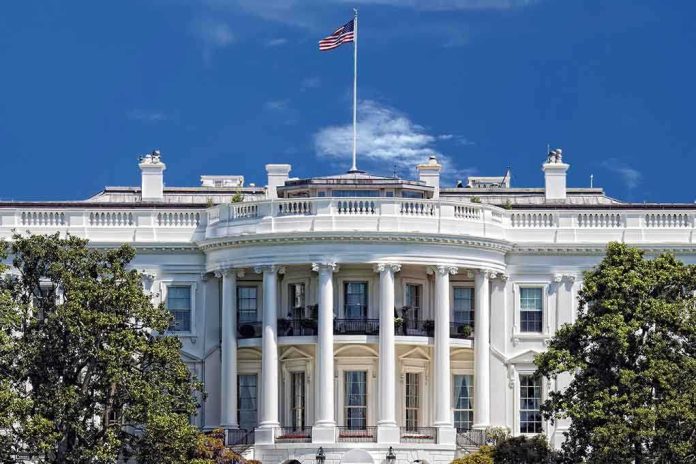
Presidents have always left their fingerprints on the White House, but the partial demolition of the East Wing to construct Donald Trump’s privately funded, 999-seat ballroom is a seismic shock to American tradition—raising questions about power, preservation, and the future of public spaces.
Story Snapshot
- Trump’s $250M ballroom expansion dwarfs any prior White House alteration and is entirely privately funded.
- Demolition began without full regulatory approval, as construction pushed forward during a government shutdown.
- The project stirs fierce debate over historic preservation, executive authority, and the use of private funds for federal landmarks.
- Completion is promised before Trump’s term ends, but experts warn the timeline is likely unrealistic.
Unprecedented Expansion Tests the Boundaries of History and Power
The White House has seen its share of renovations, but none on the scale or under the circumstances of Trump’s ballroom. In September 2025, bulldozers bit into the East Wing’s historic facade before the National Capital Planning Commission (NCPC) gave full approval—an act that flouts the protocols meant to safeguard America’s most iconic home. The $250 million project, funded exclusively by private donors, rolled forward even as a federal shutdown paralyzed other government operations, allowing construction workers to hammer away while hundreds of thousands of public employees missed paychecks.
The ballroom is designed to seat 999 guests, a staggering leap from the East Room’s 200-person capacity. Its scale has been described as “larger than the White House residence itself.” For context, Trump’s vision for a grand entertaining venue dates back to 2010, when he first floated the idea to the Obama administration—only to be rebuffed. Now, with full executive authority and a cadre of enthusiastic donors, he’s reshaping the White House in a manner that’s as much a monument to his legacy as it is a functional addition.
Regulatory Oversight and the Bypass of Preservation Protocols
Traditionally, any alteration to the White House requires a meticulous review process, with the NCPC acting as the gatekeeper for architectural and historic integrity. Yet, as of September 2025, the commission confirmed it had not received the ballroom’s full building plans—only demolition and site prep had been greenlit. Despite this, the administration pressed ahead, leveraging the argument that private funding exempted the project from the usual federal purse strings and shutdown constraints.
Preservationists and regulatory experts have sounded alarms. No sitting president has ever privately financed a major expansion of the White House. Previous projects, from the Truman Balcony to the 1902 construction of the East Wing itself, were funded and overseen by Congress. The current approach sidesteps these traditions, establishing a potential precedent: if private dollars can flow freely, does federal oversight lose its bite? Skeptics worry this opens the door to further privatization of national landmarks, where the highest donor may dictate the look and function of America’s sacred spaces.
Political Firestorm Erupts During Government Paralysis
The backdrop of the expansion—a protracted federal government shutdown—turns the ballroom into political dynamite. While construction crews are busy, federal workers are furloughed or unpaid, fueling Democratic accusations that the administration’s priorities are skewed toward spectacle over service. The optics are stark: a lavish, donor-driven project advancing while essential government functions grind to a halt. Congressional Republicans praise the use of private funds as savvy and patriotic, but critics see it as a symbol of misplaced priorities and executive overreach.
Trump’s supporters counter that the new ballroom modernizes White House operations and enhances its capacity to host major state events without burdening taxpayers. Architectural renderings, described by the BBC as “lavish,” promise crystal chandeliers, towering columns, and bulletproof glass—a venue poised to dazzle foreign dignitaries and campaign donors alike. The symbolism is clear: this is a space designed not just for governance, but for spectacle and legacy.
Historic Precedents, Uncertain Future, and the Battle for Public Spaces
No matter where one stands politically, the implications of this project are profound. In the short term, it’s a flashpoint for debates about historic preservation versus modernization, executive power versus regulatory process, and public versus private stewardship. In the long term, it may influence how future leaders approach the funding and alteration of federal properties. The ballroom could inspire more private investment in public infrastructure, but it also risks accelerating the trend toward privatization of national symbols—changing not just the White House’s architecture, but its very meaning in American life.
The experts are skeptical that construction will be completed before the end of Trump’s term in 2029; delays are likely, given the project’s scale and the regulatory questions still unresolved. Yet, even as demolition crews strip away the East Wing’s historic facade, the larger question remains: when history and ambition collide at America’s front door, who decides what endures—and who gets to put their name on it?
Sources:
Wikipedia: White House State Ballroom
White House press release, July 2025













